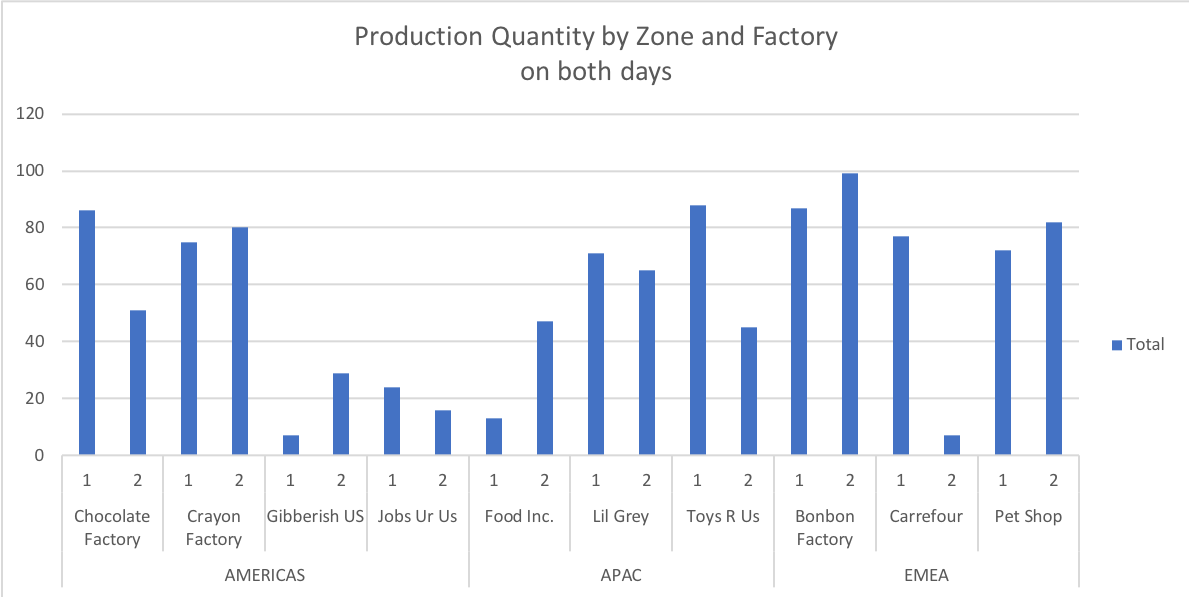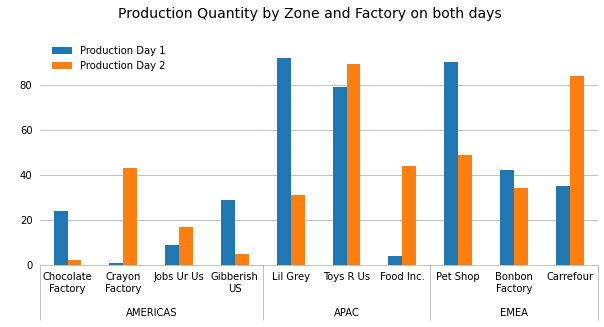DataFrame -用分组列(至少两列)绘制数据帧的条形图
DataFrame -用分组列(至少两列)绘制数据帧的条形图
提问于 2021-02-02 19:05:26
我一直在努力使用matlplotlib在python中重新创建这个Excel图:

数据在一个dataframe中;我正在尝试自动化生成这个图的过程。
我尝试过打开我的数据堆栈,进行细分,但是我还没有创建"Zone“索引,这个索引在Excel中是如此优雅。我已经成功地绘制了没有这个“区域”索引的图表,但这并不是我真正想要做的。
这是我的代码:
data = pd.DataFrame(
{
'Factory Zone':
["AMERICAS","APAC","APAC","APAC","APAC","APAC","EMEA","EMEA","EMEA","EMEA"],
'Factory Name':
["Chocolate Factory","Crayon Factory","Jobs Ur Us", "Gibberish US","Lil Grey", "Toys R Us","Food Inc.",
"Pet Shop", "Bonbon Factory","Carrefour"],
'Production Day 1':
[24,1,9,29,92,79,4,90,42,35],
'Production Day 2':
[2,43,17,5,31,89,44,49,34,84]
})
df = pd.DataFrame(data)
print(df)
# Without FactoryZone, it works:
df = df.drop(['Factory Zone'], axis=1)
image = df.plot(kind="bar")数据看起来如下:
Unnamed: 0 FactoryZone Factory Name Production Day 1 Production Day 2
0 1 AMERICAS Chocolate Factory 24 43
1 2 AMERICAS Crayon Factory 1 17
2 3 EMEA Pet Shop 9 5
3 4 EMEA Bonbon Factory 29 31
4 5 APAC Lil Grey 92 89
5 6 AMERICAS Jobs Ur Us 79 44
6 7 APAC Toys R Us 4 49
7 8 EMEA Carrefour 90 34
8 9 AMERICAS Gibberish US 42 84
9 10 APAC Food Inc. 35 62回答 3
Stack Overflow用户
回答已采纳
发布于 2021-02-09 14:50:39
您可以首先为分层数据集创建一个MultiIndex,其中0级是工厂区域,级别1是工厂名称
import numpy as np # v 1.19.2
import pandas as pd # v 1.1.3
import matplotlib.pyplot as plt # v 3.3.2
df = pd.DataFrame(
{'Factory Zone': ['AMERICAS', 'AMERICAS', 'AMERICAS', 'AMERICAS', 'APAC',
'APAC', 'APAC', 'EMEA', 'EMEA', 'EMEA'],
'Factory Name': ['Chocolate Factory', 'Crayon Factory', 'Jobs Ur Us',
'Gibberish US', 'Lil Grey', 'Toys R Us', 'Food Inc.',
'Pet Shop', 'Bonbon Factory','Carrefour'],
'Production Day 1': [24,1,9,29,92,79,4,90,42,35],
'Production Day 2': [2,43,17,5,31,89,44,49,34,84]
})
df.set_index(['Factory Zone', 'Factory Name'], inplace=True)df
# Production Day 1 Production Day 2
# Factory Zone Factory Name
# AMERICAS Chocolate Factory 24 2
# Crayon Factory 1 43
# Jobs Ur Us 9 17
# Gibberish US 29 5
# APAC Lil Grey 92 31
# Toys R Us 79 89
# Food Inc. 4 44
# EMEA Pet Shop 90 49
# Bonbon Factory 42 34
# Carrefour 35 84就像广黄提议的那样,你可以为每个区域创建一个子小区,并将它们粘在一起。每个子图的宽度必须通过使用width_ratios字典中的gridspec_kw参数来根据工厂的数量进行校正,这样所有的列都具有相同的宽度。然后有无限的格式选择要做。
在下面的示例中,我选择只显示区域之间的分隔线,并为此使用较小的勾号。此外,由于图形宽度在这里仅限于10英寸,我在两行上重写了较长的标签。
# Create figure with a subplot for each factory zone with a relative width
# proportionate to the number of factories
zones = df.index.levels[0]
nplots = zones.size
plots_width_ratios = [df.xs(zone).index.size for zone in zones]
fig, axes = plt.subplots(nrows=1, ncols=nplots, sharey=True, figsize=(10, 4),
gridspec_kw = dict(width_ratios=plots_width_ratios, wspace=0))
# Loop through array of axes to create grouped bar chart for each factory zone
alpha = 0.3 # used for grid lines, bottom spine and separation lines between zones
for zone, ax in zip(zones, axes):
# Create bar chart with grid lines and no spines except bottom one
df.xs(zone).plot.bar(ax=ax, legend=None, zorder=2)
ax.grid(axis='y', zorder=1, color='black', alpha=alpha)
for spine in ['top', 'left', 'right']:
ax.spines[spine].set_visible(False)
ax.spines['bottom'].set_alpha(alpha)
# Set and place x labels for factory zones
ax.set_xlabel(zone)
ax.xaxis.set_label_coords(x=0.5, y=-0.2)
# Format major tick labels for factory names: note that because this figure is
# only about 10 inches wide, I choose to rewrite the long names on two lines.
ticklabels = [name.replace(' ', '\n') if len(name) > 10 else name
for name in df.xs(zone).index]
ax.set_xticklabels(ticklabels, rotation=0, ha='center')
ax.tick_params(axis='both', length=0, pad=7)
# Set and format minor tick marks for separation lines between zones: note
# that except for the first subplot, only the right tick mark is drawn to avoid
# duplicate overlapping lines so that when an alpha different from 1 is chosen
# (like in this example) all the lines look the same
if ax.is_first_col():
ax.set_xticks([*ax.get_xlim()], minor=True)
else:
ax.set_xticks([ax.get_xlim()[1]], minor=True)
ax.tick_params(which='minor', length=55, width=0.8, color=[0, 0, 0, alpha])
# Add legend using the labels and handles from the last subplot
fig.legend(*ax.get_legend_handles_labels(), frameon=False, loc=(0.08, 0.77))
fig.suptitle('Production Quantity by Zone and Factory on both days', y=1.02, size=14);

参考文献: Quang,这是gyx的答案。的答案
Stack Overflow用户
发布于 2021-02-02 19:25:43
给出一个紧密的情节的一个想法是在一个子图中将每个Factory Zone绘制成一个彼此相邻的子图:
# setting up the subplots
fig, axes = plt.subplots(1, len(df['Factory Zone'].unique()),
figsize=(12,4),
sharex=True, sharey=True,
gridspec_kw={'wspace':0},
subplot_kw={'frameon':False})
# use groupby to loop through the `Factory Zone`
for (k,d), ax in zip(df.groupby('Factory Zone'), axes):
# plot the data into subplot
d.plot.bar(x='Factory Name', ax=ax)
# set label to the `Factory Zone`
ax.set_xlabel(k)
# remove the extra legend in each subplot
legend = ax.legend()
handlers = ax.get_legend_handles_labels()
ax.legend().remove()
ax.grid(True, axis='y')
# reinstall the last legend
ax.legend(*handlers)输出:

Stack Overflow用户
发布于 2022-06-23 19:21:20
Patrick提供的解决方案只有一行,它在Matplotlib 3.4中被废弃,并将在2个小版本中被删除。(我认为这是一种评论,而不是回答,但我还没有足够的声誉!)
更改:
if ax.is_first_col():至
if ax.get_subplotspec().is_first_col():页面原文内容由Stack Overflow提供。腾讯云小微IT领域专用引擎提供翻译支持
原文链接:
https://stackoverflow.com/questions/66016045
复制相关文章
相似问题

